MSI GT627: Bringing Balance to the Force?
by Jarred Walton on April 29, 2009 4:00 AM EST- Posted in
- Laptops
Power Requirements
Power requirements with a laptop plugged in don't necessarily reflect power requirements when a laptop is on battery power. In particular, high-end GPUs run at lower maximum clock speeds when using the battery. Keep this in mind when looking at the following numbers. We test under idle conditions, with a 100% load placed on the CPU via Folding@Home SMP, and finally at maximum load by running FAH SMP at the same time as we loop 3DMark06 (at the native LCD resolution).
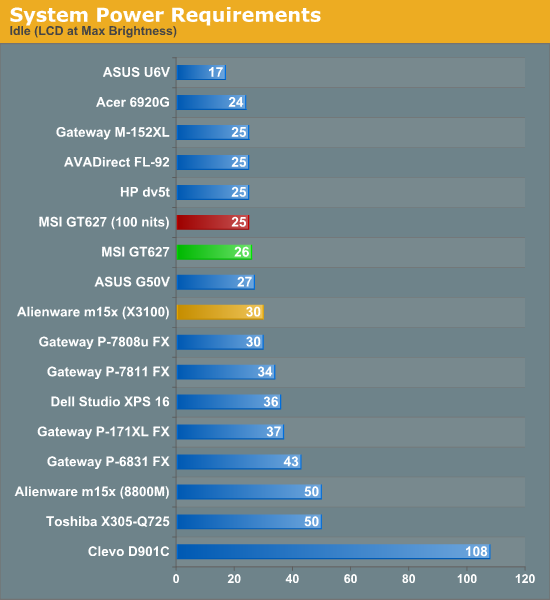
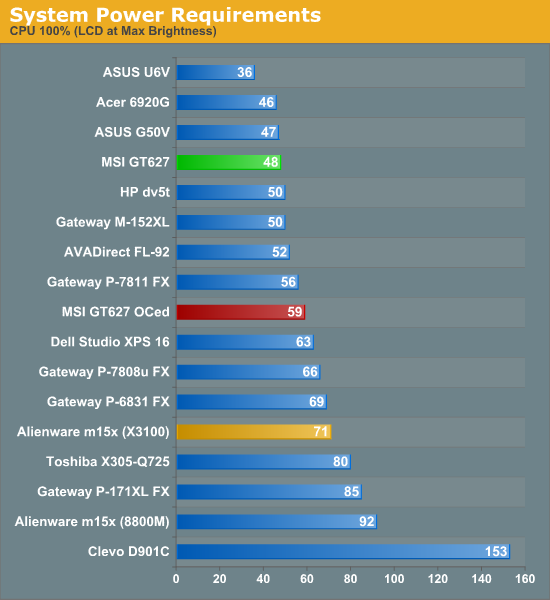
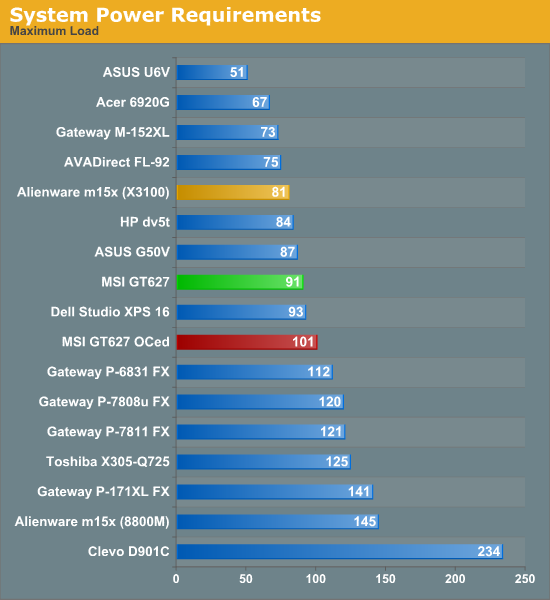
Our power measurements are with the LCD at maximum brightness, which isn't necessarily a fair way of doing things as some LCDs are much brighter than others are. Unfortunately, we don't have most of the laptops around to retest. The MSI GT627 only uses 1W more power running at maximum brightness, however, which represents an increase in power draw of just 4%. On the other hand the Dell Studio XPS 16 only uses 9W (33%) more power at maximum brightness. The other interesting thing to look at is power requirements when the CPU is overclocked. Since it's extremely simple to enable/disable overclocking (press the Turbo button), we only recommend it when you're doing something that's CPU intensive. In such situations, overclocking increases power requirements by 10-11W. You definitely wouldn't want to overclock the system when you're running on battery power!
In terms of overall power requirements, the 15.4" chassis helps MSI to provide reasonable gaming performance without using substantially more power than some non-gaming (i.e. GeForce 8600M or lower GPU) laptops. Looking at battery life and performance, the MSI GT627 would be a far better choice than laptops like the HP dv5t or Gateway M152-XL. Either buy a laptop that offers noticeably better battery life and lower performance, or jump to the MSI GT627. Graphics chips like the GeForce 8600M/9500M and Mobility Radeon 3650 just seem to use too much power and offer too little performance in return.
Noise Levels
We also ran noise testing using an SPL meter at 24" under the same conditions as our power tests.
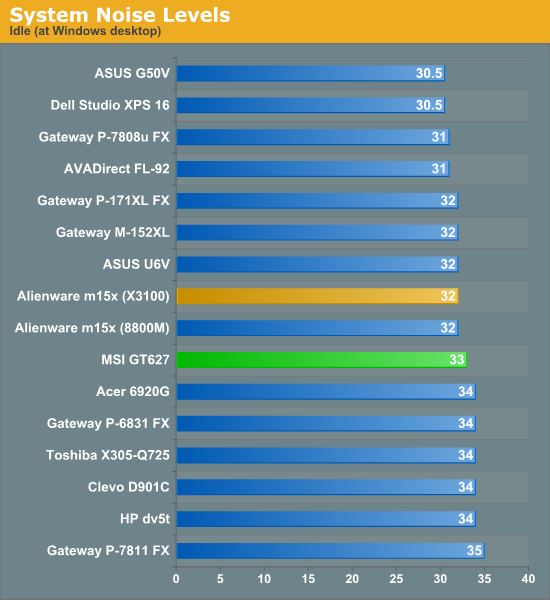
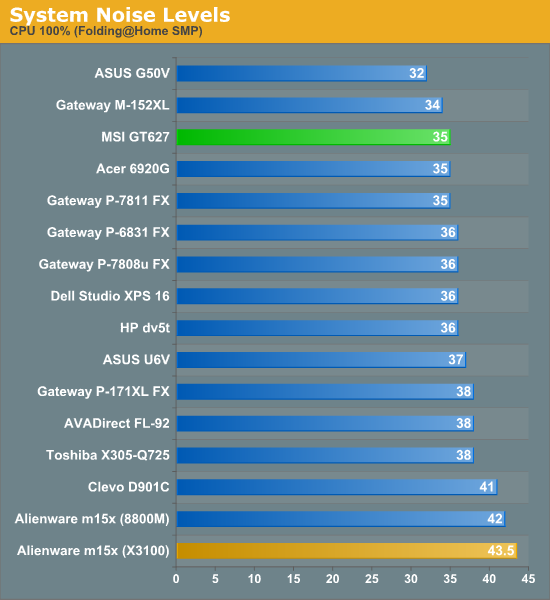
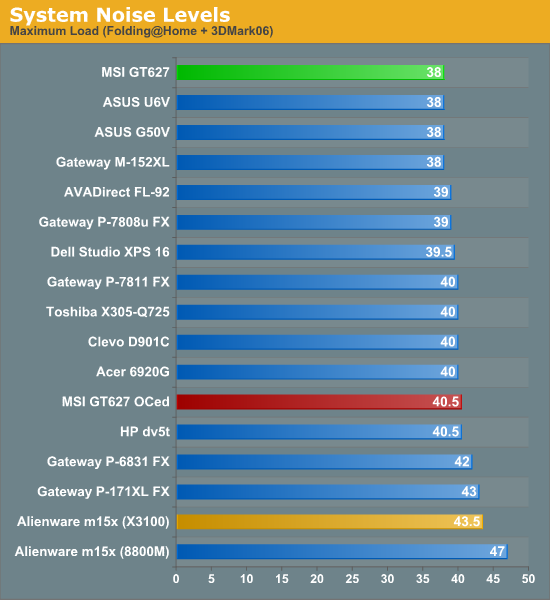
Idle noise levels aren't the best, but otherwise the GT627 does quite well in this test. Also interesting to note is that overclocking didn't affect idle noise levels, but it did add over 3dB to the CPU and maximum load results.
Temperatures
We didn't create any charts, but we wanted to give a quick rundown of the temperatures you might expect from the GT627. We placed a maximum load on the system for 60 minutes (looping 3DMark06) and then measured temperatures, so these results are something of a worst-case scenario. However, the testing environment was only 67°F, so in warmer conditions the notebook will likely run a bit warmer. Also note that the notebook was sitting on a hard, flat surface - you can use it on your lap, but if you block the ventilation slats temperatures may also increase.
We measured temperatures of up to 50°C at the exhaust, which is by far the hottest spot on the chassis. Temperatures on the bottom of the laptop range from 24° to 41°, with most of the bottom measuring around 35°C. The keyboard and palm rest aren't quite as hot, ranging from 25° to 33°C with most of the keyboard staying under 30°. Compared to the Gateway P-7808u, a few areas are slightly hotter but overall the difference is less than a couple degrees. The combination of slightly lower performing parts with a smaller 15.4" chassis works well.










47 Comments
View All Comments
B3an - Wednesday, April 29, 2009 - link
I'm not buying a new laptop until i can get one with a decent display. I agree with this review about the poor displays in most of them. I've been waiting 2 years so far to upgrade to something like a LED backlit laptop with a good screen res and image quality, or just one with a good IPS and normal backlighting even. But they're taking there time!!Hrel - Wednesday, April 29, 2009 - link
The review laptop needs to be $900 or less, simply look at this one: http://www.bestbuy.com/site/olspage.jsp?skuId=9050...">http://www.bestbuy.com/site/olspage.jsp...&typ...The MSI Model with the faster CPU and higher resolution screen should be about $1100.
Finally, crappy keyboard and cracking chassis' WHILE IN A BAG is just completely unacceptable. I think right now the Asus is still the way to go; though I really would like to see a higher resolution screen. 1520x855 or 1600x900 like Sony offers would be GREAT!!!
Hrel - Wednesday, April 29, 2009 - link
That's amazing, the MSI is at the top of the list every single time; it even manages to beat out the Clevo at least once; then it's second the other times. Simply awesome! Can't believe that small overclock makes that big of a difference.Hrel - Wednesday, April 29, 2009 - link
I'm referring to the gaming test in the above comment; just to be clear.Mikey - Wednesday, April 29, 2009 - link
I think this is a great review for a great notebook. Never is there anything that is ever perfect when it comes to new tech in the market, but this MSI notebook can do it all. I don't know why these companies don't have the brains to use common sense and fix these little "issues" that people have with it. Don't they know that they could make a better product using better material? So what if it costs $100 more. I think that is worth the improvements that most people within this market segment is looking for.http://www.dumpsternationwide.com/">roll off dumpsters and containers>
crimson117 - Wednesday, April 29, 2009 - link
How do you think the screen will be on this one? 17", 1680x1050, and claims to include "MSI vivid image enhancement technology"http://www.msimobile.com/level3_productpage.aspx?c...">http://www.msimobile.com/level3_productpage.aspx?c...
JarredWalton - Wednesday, April 29, 2009 - link
Well, I can't say without testing in person, but take http://www.samsung.com/global/business/lcdpanel/pr...">Samsung's current laptop LCDs as a starting point. Their 17" option with WSXGA+ resolution lists a 45% color gamut (blech!), 300 nit brightness, and no contrast ration. There's a good chance that it will be a 500:1 contrast or higher, but no guarantee. If you walk down the aisles at Best Buy, Office Depot, or a similar store and look at the displays, you will likely notice that around 60-75% have poor contrast ratios, and all of them are TN panels.crimson117 - Wednesday, April 29, 2009 - link
I guess what I really want is a Dell Studio XPS 16 with a better graphics card (such as a AMD Mobile 4850).IlllI - Wednesday, April 29, 2009 - link
i'd be careful with dell. they've been known in the past to do 'panel lottery' so you might not get the same kind of lcd panel that they have in it nowJarredWalton - Wednesday, April 29, 2009 - link
I'm pretty sure if you get one of the Dell laptops with a high color gamut RGB LED backlit LCD, the panels will all come from the same source (i.e. no lottery). I only know of one manufacturer doing RGB LEDs right now, at least (Seiko Epson).